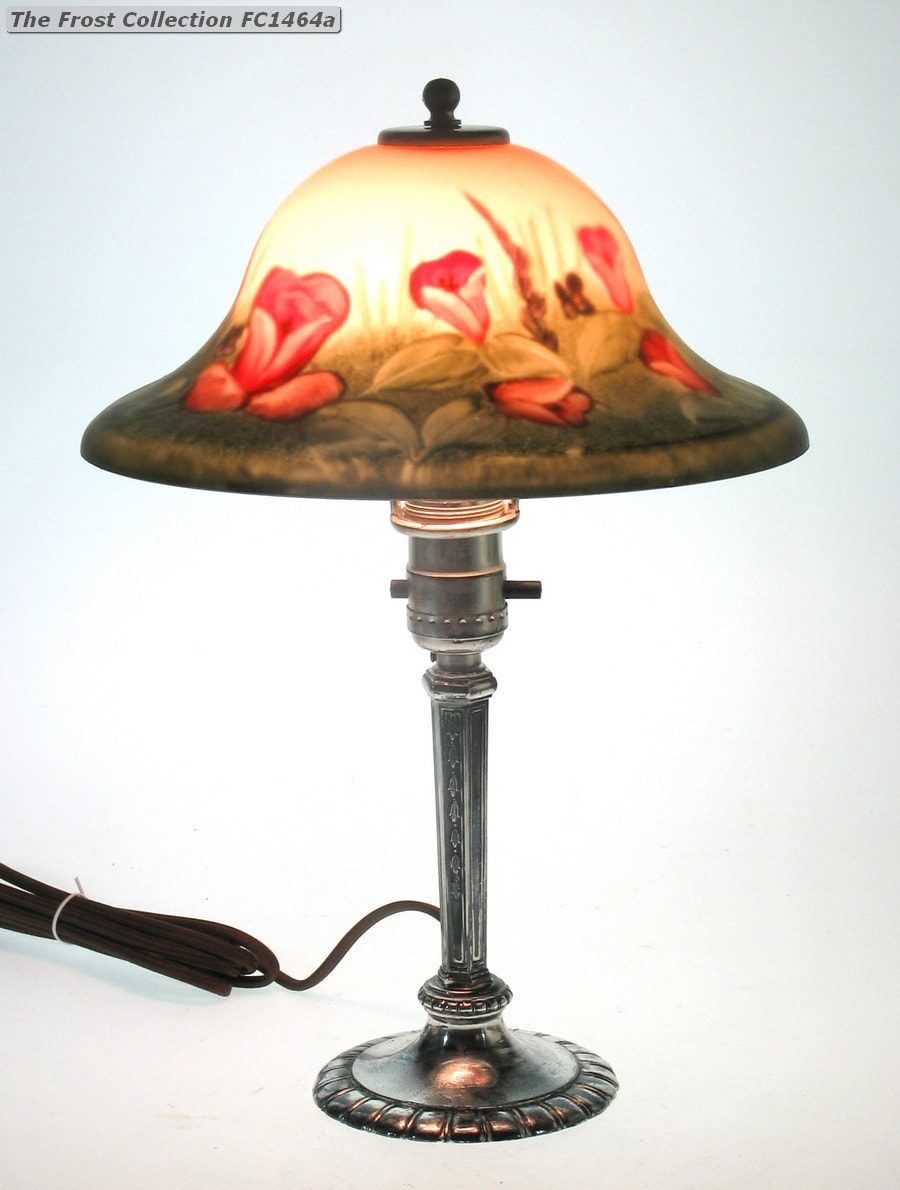Pairpoint Lamps Rescued and Restored
Sandy and I have become very interested in the preservation of Pairpoint Lamps. We have noticed for years the proliferation of unused and discarded bases because they are missing their original decorated glass shades. Let’s face it, what good is a lamp without a shade, especially when Pairpoint was known for their glass puffy and reverse-painted shades? In the hundred years that have passed since these lamps were popular, many, many shades were broken or lost, and they’re not replaceable. For many people, when the shade is broken, the base is rendered useless and unwanted. This line of thinking is unfortunate but is a reality.
Most people don’t realize that Pairpoint offered their lamps in scores of configurations and finishes that included numerous hardware variations. Additionally, while most famous for their beautiful decorated glass shades, Pairpoint offered many of their lamp styles with numerous plain and decorated parchment and silk shades in oval, conical, and Empire-style configurations. One of Pairpoint’s suppliers was the Murray M. Harvey Manufacturing Co., located at 6 E. 39th Street, New York. Armed with this knowledge, no Pairpoint lamp base needs to be abandoned for want of a glass shade. All that needs to be done to resurrect these lamps, and maintain their originality, is to slightly reconfigure the top hardware to accept an alternative shade that Pairpoint may have and could have offered at the time of sale. After all, this is what Pairpoint did when a customer wanted something other than a Puffy or Reverse-Painted shade. Pairpoint offered hundreds of configurations for their bases. Remember, Pairpoint Lamps are defined and cataloged by their base, not their shade. A Pairpoint lamp today, having a later shade replacement does not make the lamp any less-Pairpoint.
Arguably, no lamp manufacturer from any decade over the last hundred years made better lamps than Pairpoint; lamps purchased today cannot come close to the quality of materials, workmanship, or design…and they are expensive. An astute consumer, having an eye for quality and an appreciation of history, would serve himself well to purchase a derelict Pairpoint lamp base and have it restored and rewired prior to installing a current silk or parchment shade or even a well-styled reverse-painted glass shade which are still available in the secondary market. When all is said and done, the consumer will have a high quality historically significant utilitarian work of art to fill a necessary place in the home. And, the lamp will retain its value while a new lamp depreciates to second-hand status as soon as it leaves the retail store.
Most people don’t realize that Pairpoint offered their lamps in scores of configurations and finishes that included numerous hardware variations. Additionally, while most famous for their beautiful decorated glass shades, Pairpoint offered many of their lamp styles with numerous plain and decorated parchment and silk shades in oval, conical, and Empire-style configurations. One of Pairpoint’s suppliers was the Murray M. Harvey Manufacturing Co., located at 6 E. 39th Street, New York. Armed with this knowledge, no Pairpoint lamp base needs to be abandoned for want of a glass shade. All that needs to be done to resurrect these lamps, and maintain their originality, is to slightly reconfigure the top hardware to accept an alternative shade that Pairpoint may have and could have offered at the time of sale. After all, this is what Pairpoint did when a customer wanted something other than a Puffy or Reverse-Painted shade. Pairpoint offered hundreds of configurations for their bases. Remember, Pairpoint Lamps are defined and cataloged by their base, not their shade. A Pairpoint lamp today, having a later shade replacement does not make the lamp any less-Pairpoint.
Arguably, no lamp manufacturer from any decade over the last hundred years made better lamps than Pairpoint; lamps purchased today cannot come close to the quality of materials, workmanship, or design…and they are expensive. An astute consumer, having an eye for quality and an appreciation of history, would serve himself well to purchase a derelict Pairpoint lamp base and have it restored and rewired prior to installing a current silk or parchment shade or even a well-styled reverse-painted glass shade which are still available in the secondary market. When all is said and done, the consumer will have a high quality historically significant utilitarian work of art to fill a necessary place in the home. And, the lamp will retain its value while a new lamp depreciates to second-hand status as soon as it leaves the retail store.







